On the last weekend of September, I had the biggest tournament of my life— the AGE Player’s Championship. I competed in 8 AGE Opens to qualify and in each CC tournament, I ran Riptide.
I knew I was going to run Riptide for the championship.
With the tournament just a week after Rosetta’s release and the meta still settling after the infamous Book Ban, everything was up in the air. It felt like anyone could play any hero. Despite this openness, there was an air of concern that the type of decks played might not be as diverse as the hero choices lead you to believe.
That was because of Count Your Blessings.
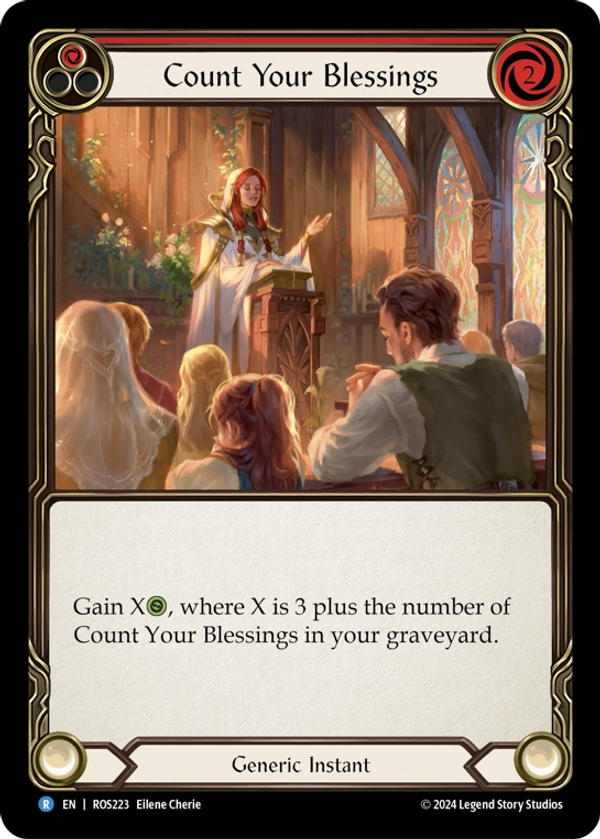
By this point, you’ve surely heard about Count Your Blessings. Is it strong? Is it a trap? Should it be banned? In this article, I’ll be breaking down my thoughts on the card and the ways it shifts how we should be evaluating card value in our games. Along the way, you’ll get to hear about my CYB stress test as I play it in the most degenerate deck I could think of: Fatigue Riptide.
Evaluating CYB
When you are evaluating any card, it’s standard to assign points of value. If I attack with a red Wounding Blow, I get 4 points of value from the 4 damage it is threatening. If I attack with a red Fyendal’s Fighting Spirit while lower on life, I get 8 points of value: 7 damage and 1 point of life gain. Assuming I pitched a blue to play it, that means that I spent 2 cards from hand for 8 points of value, giving me a rate of 4 points per card.
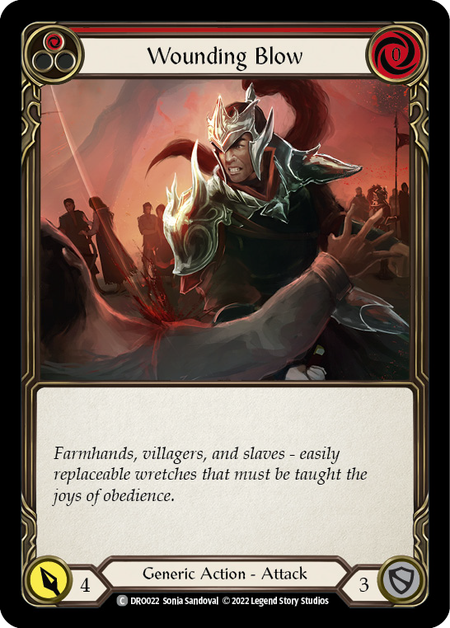
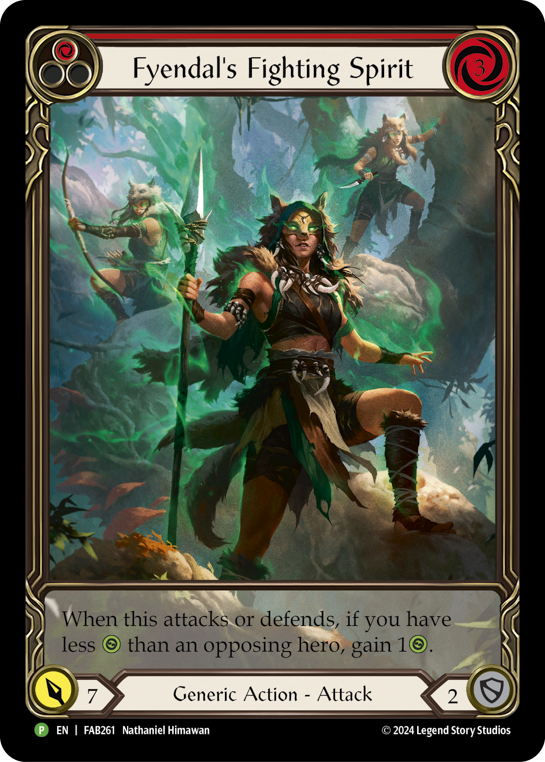
The standard point value per card is 3. If you can play out a hand that gives more than 3 value per card, you’re generally in a good spot.
Most decks, especially aggro decks, seek to get the most value per card per hand. They want to be pushing these big turns where each card is giving you 4 or 5 points of offensive value.
However, that is not how fatigue decks value cards. Fatigue decks look to outlast all of your major threats and whittle down your deck through consistent pressure. If you run out of cards, you won’t be able to block out the weapon that they are swinging every turn. For fatigue, life is a resource. The true path to victory is deck size.
The metric then shifts from “how much value can I get per card in hand?” to “how much value can I get per card leaving my deck?”
And this is where Count Your Blessings excels.
CYB Math
Each copy of Count Your Blessings in your graveyard gives each other CYB +1 life gain. Assuming you are able to play every copy and none are exiled from your graveyard, that is 54 total life gain. That is an insanely huge number - but how you evaluate the value per card will give you a better picture of how the card operates in practice.
CYB gets better as the game goes on. To start, you will only be gaining 1-3 life based on the pitch value of the CYB. If your first cast is a blue CYB, then you are getting a measly 0.5 value per card— spending 2 to gain 1 life. Of course the flip side is the value your later CYBs get. If you play a red CYB after playing the other 8, you’ll be gaining 11 life— a whooping 5.5 value per card!
Right away, this shows us a weakness of CYB decks: They are slow. Their hands are inefficient and full of no-blocks, meaning you can try and rush them down. It also means that they have less tools to push the offensive when left with full hands.
If we expand our scope a bit and divide the 54 total life gain by each card-in-hand spent to get there (9 CYB and 9 pitched cards), you’ll find that the overall card-in-hand point evaluation of CYB is… just 3. Perfectly on par.
But this is a "value by cards in hand" perspective. What about the cards-in-deck numbers?
If we care more about cards in deck, the cards we pitch aren’t really gone or wasted. They are still there ready to give us value when they come back around. This means that the overall value is just the 54 total life divided by the 9 CYB’s we have to play to get there. By that metric, each card gives us 6 total value, which is well above rate.
This is the strength of Count Your Blessings.
Life is a valuable defensive tool, especially against attackers with many individual one-off pings. Spending a whole card to block a 1-attack dagger just gives you 1 point of value. That’s why breakpoints are so important: they force your opponent to overblock. Life never overblocks. Each point of life gain is one dagger or rune chant or trap ping that you have “blocked.”
Plus, life gain can stack. If I take an off turn to gain 6 life, that 6 life is sticking around for whenever I need it. This can be especially helpful if you are trying to gain life to sit above Verdance's combo kill range, for example.
Who Can Use CYB?
Ok, so we’ve gone over all the math. But who can actually make use of this? Well, anyone! (Kind of…)
Since CYB is a generic, any hero can run the card. However, that takes 9 slots of your deck and fills them with slow no-blocks. Certain heroes will be able to make better use of that than others.
One especially scary choice is Enigma. Enigma already messes with the standard value of cards by building up a board state that serves as both recurring offensive tools and a standing defense. Adding CYB allows the game to go longer, a bigger board to be built, and asks opposing decks to fight through a wall of ward to kill Enigma early.
Another major thing to consider is the extra resource you get when pitching a blue to play CYB. What can you use that for?
Warrior has Hatchet of Body and Hatchet of Mind they can use to swing with 1 resource. Guardian can use that resource defensively to activate Rampart of the Ram’s Head.
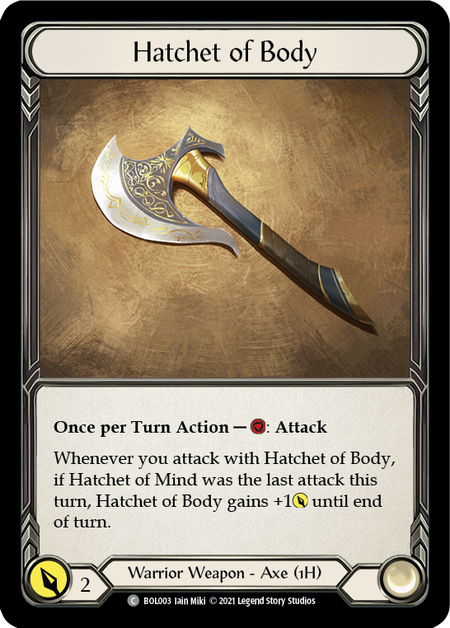
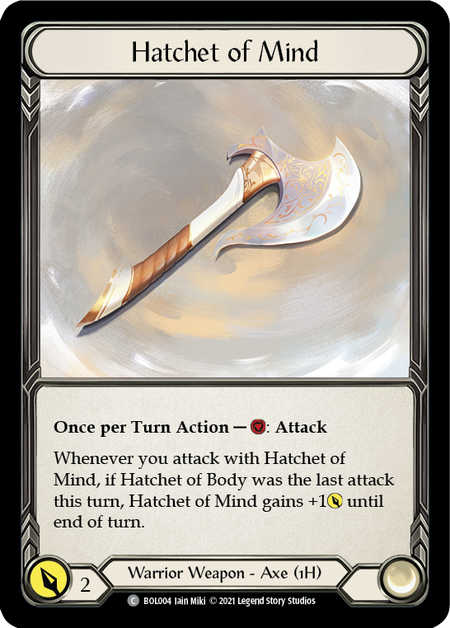
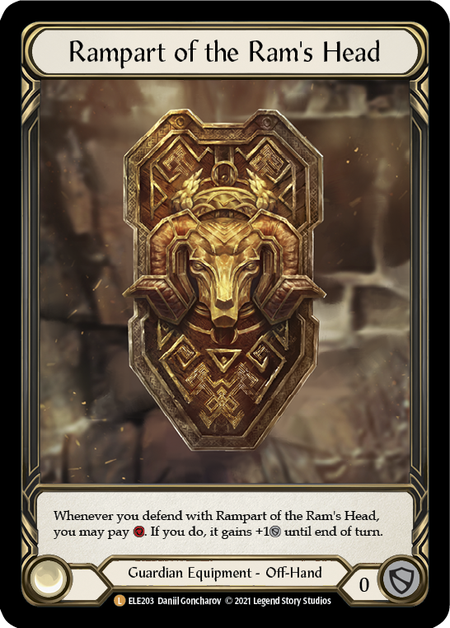
This is what drew me to trying CYB in Riptide. Not only can we use the one resource, Riptide gives CYBs the ability to reload. We also have a unique suite of tools that could really punish a CYB meta…
Fatigue Riptide
I’ve written about Fatigue Riptide before and it holds a special place in my TCG heart. It’s rarely the most viable choice, but it is certainly a lot of fun. I’ve been on more midrange Riptide builds recently, but I expected these to do poorly in the new meta. Those decks rely on pushing damage on awkward on-hits before finishing off people with traps. But with all the life gain now running around, that hyper-value build doesn’t work. After all, we don’t have a weapon to close out the end game. The 54 life gained from CYB can make it difficult for any Riptide to push enough damage to close a game with the limited amount of attacks we get.
So that leaves me with two options: 1) Play aggro Riptide and hope to kill decks before they go online. 2) Play fatigue Riptide and use his unique tools to punish unprepared decks.
For me, the decision was simple. I don’t like playing aggro, so fatigue here I come!
After a few weeks of testing, I ended on this list.
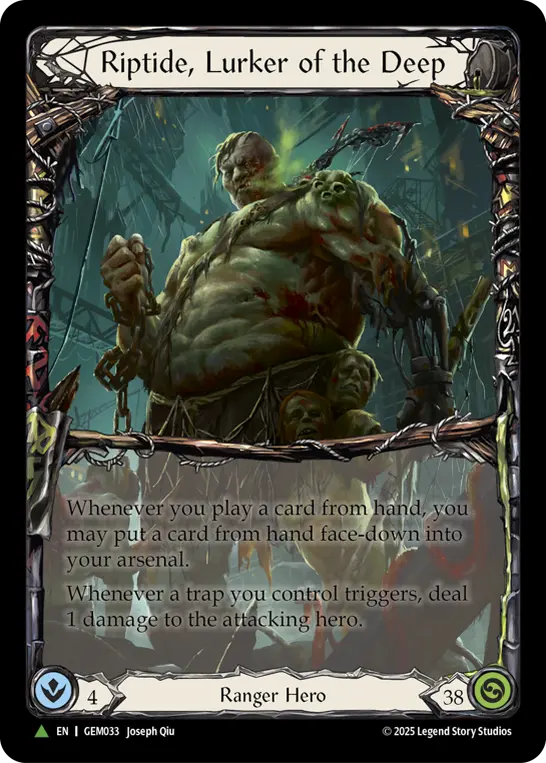
Weapons
- Dreadbore (1)
Equipment
- Bull's Eye Bracers (1)
- Crown of Providence (1)
- Perch Grapplers (1)
- Longdraw Half-glove (1)
- Nullrune Boots (1)
- Quiver of Abyssal Depths (1)
- Trench of Sunken Treasure (1)
Loadout
- Battering Bolt (Red) (3)
- Collapsing Trap (Blue) (1)
- Buzzsaw Trap (Blue) (1)
- Codex of Frailty (Yellow) (3)
- Frailty Trap (Red) (3)
- Remembrance (Yellow) (3)
- Salvage Shot (Red) (3)
- Murky Water (Red) (3)
- Boulder Trap (Yellow) (3)
- Tripwire Trap (Red) (2)
- Command and Conquer (Red) (3)
- Salvage Shot (Blue) (3)
- Murkmire Grapnel (Red) (2)
- Pitfall Trap (Yellow) (3)
- Inertia Trap (Red) (3)
- Pendulum Trap (Yellow) (1)
- Release the Tension (Red) (3)
- Poison the Well (Blue) (1)
- Remorseless (Red) (3)
- Salvage Shot (Yellow) (3)
- Endless Arrow (Red) (3)
- Spike Pit Trap (Blue) (1)
- Take Cover (Red) (3)
- Tarpit Trap (Yellow) (3)
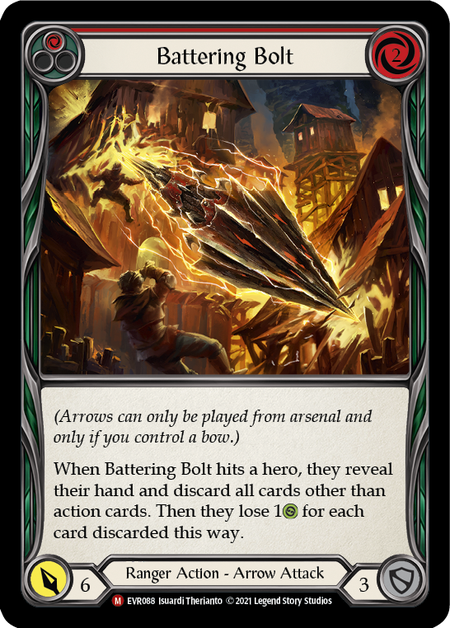
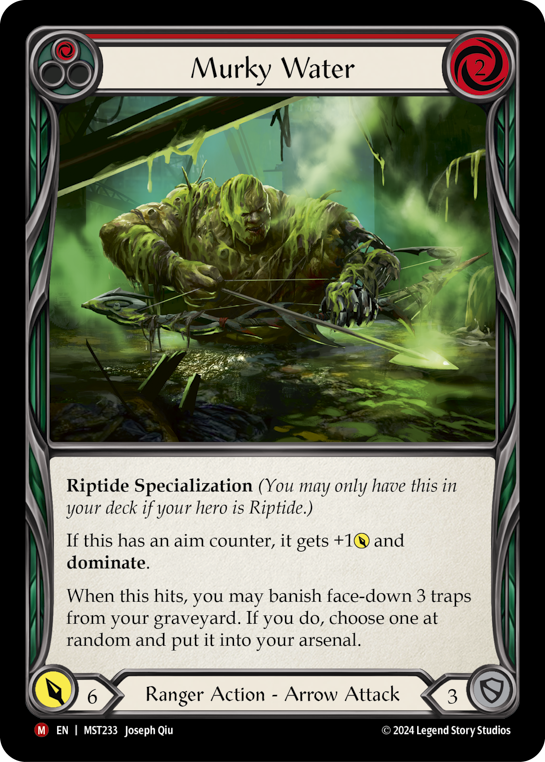
The basics are very similar to the Fatigue Riptide list I wrote about in my first Rathe Times article. With Dreadbore making defense reactions dead cards in hand, you can force opponents to block with 2-3 cards to stop an un-pumped arrow. In particular, Battering Bolt and Murky Water present important on-hits while also coming in for 7 off of Dreadbore.
Rainbow Salvage Shot and Endless Arrow are our pseudo-weapons. If any hit, we are dealing damage while not losing any cards from our deck. In the end game, the opponent might be sitting on all d-reacts making it incredibly difficult to block out any of these arrows.
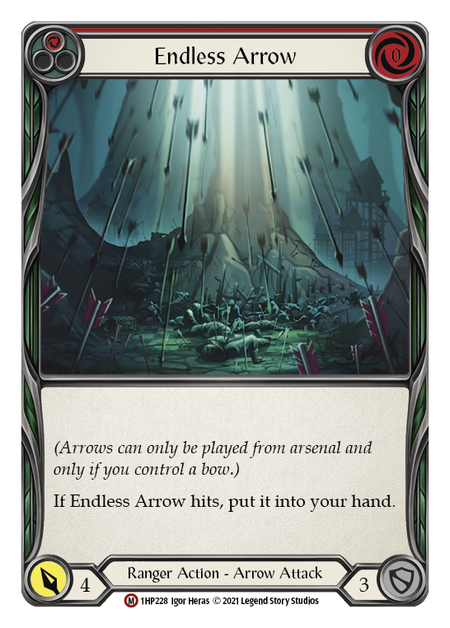
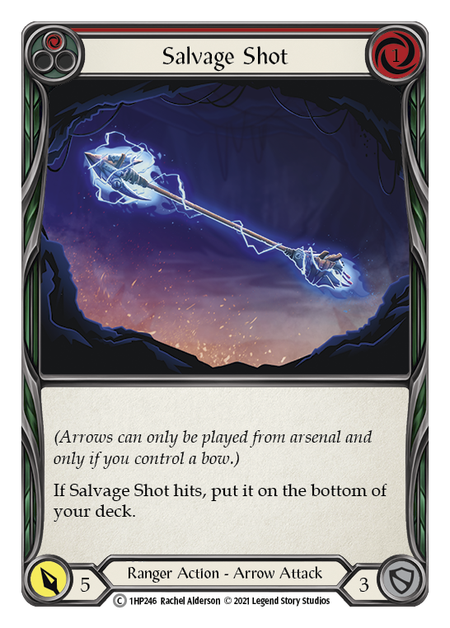
We have some other standards: Codex of Frailty, Remorseless, and Command and Conquer. Notably, there aren’t any Enlightened Strikes. For this build, I decided to only run cards that could evade d-reacts. In fact, I even added 3 Release the Tensions in the sideboard to help with this evasion against the grindier decks.

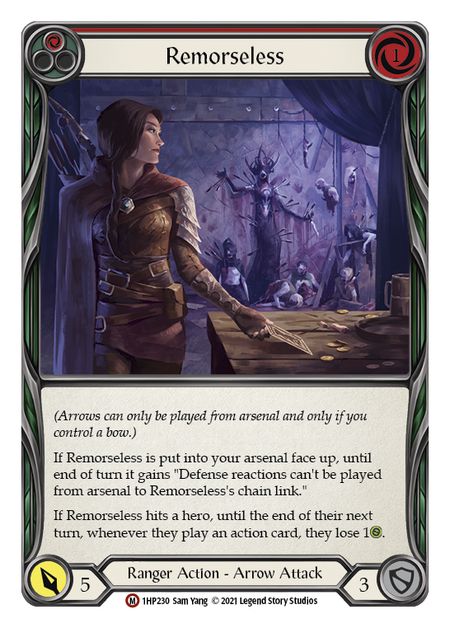
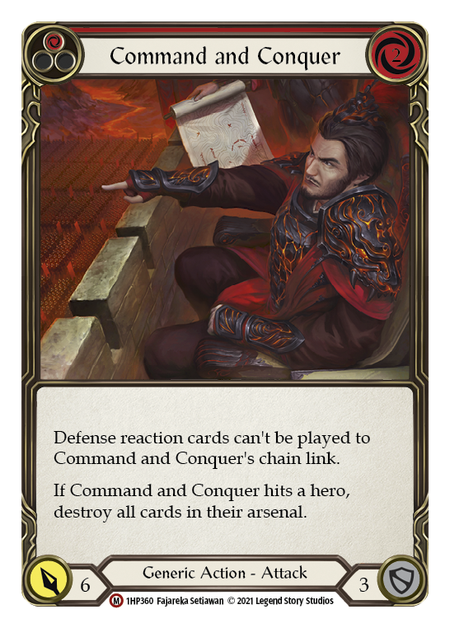
The sideboard also included AB3, 3 Remembrances, and a single Poison The Well.
Oddly enough, this Poison the Well wasn’t even for opposing CYB decks. I think Riptide has some unique play into CYB which I’ll get to in a minute. This was actually for Florian. My friend and testing partner Fuzzy ran Florian at the AGE Championship, and I knew my first match was on Florian. In our testing games, Fuzzy won by using Reaping Blade to keep me from padding my life. He played a more aggressive plan, bringing both our life totals low where he could stack Runechants by casting Germinate 4 times (grabbing one back with Plume). Because this strategy was so consistent, Poison the Well was a way to swing that late game life total in a favorable way.
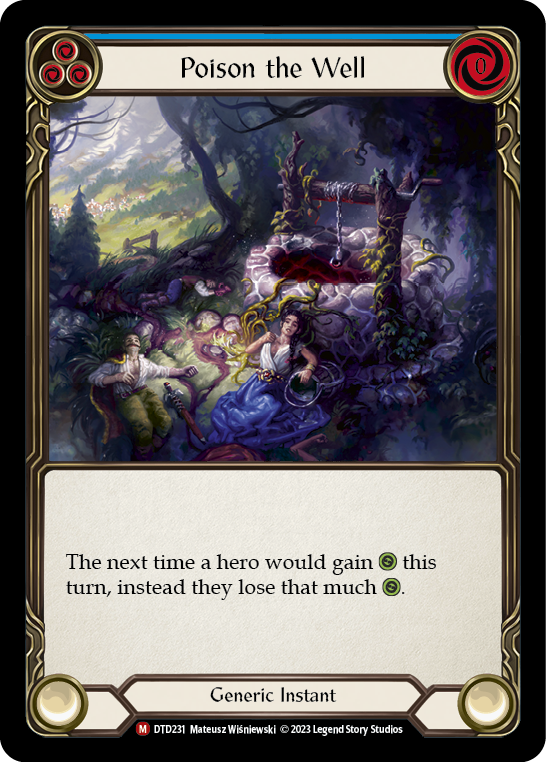
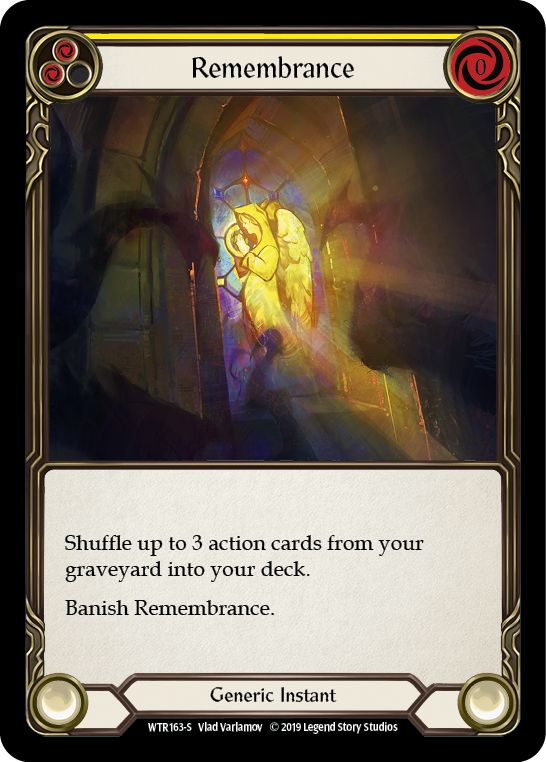
So, out of all the heroes, why CYB Riptide?
Well, I think Riptide is uniquely positioned to make use of CYB in a list that could take many by surprise. We already talked about Dreadbore forcing our opponent to block with cards from their deck, but there is another factor here: Riptide is disruptive on defense.
The king of this is Collapsing Trap, which can strip cards from hand or shut down an otherwise power turn. We also have Boulder Trap to chip equipment, Inertia Trap to clear arsenals, and Tarpit Trap to negate important on-hits. In this latest set, we got another important tool: Plan for the Worst.
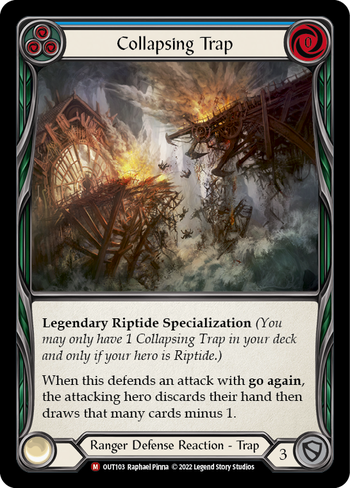
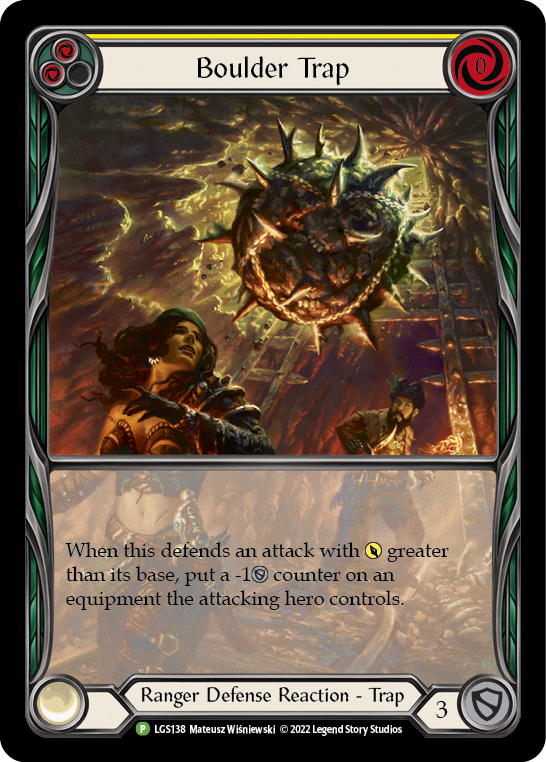
Plan for the Worst is a weird card, but it does three things. 1) It gives me perfect information for the opponent’s hand and arsenal. 2) It allows me to grab the trap(s) to withstand that hand. 3) It destroys their hand and arsenal, forcing them to play out what you saw.
If Plan for the Worst is your only card in hand, you get one trap to park in arsenal. If you have more cards in hand, you can grab— and keep— all three of the traps if you want. This means that you are much more likely to see things like Collapsing Trap and Buzzsaw Trap in crucial matches. This is also a way to clear pesky d-reacts from the opponent’s arsenal or force out key power cards. In my first game against Florian, I was able to use Plan for the Worst to force out 2 Germinates before they turned on his hero ability. Into Wizards, you can grab 3 blue traps to stock up for a big AB turn. Usually though, I’m grabbing Tripwire Trap. Tripwire can only be played from arsenal, but is a 0 for 4 red block that always pings 1 with Riptide. Ensuring I can grab that for my arsenal is key and keeps it from being a dead card on an awkward hand
These are all tools that Riptide can use regardless if an opponent blocks or not. Plus, we have one of the most disruptive tools to defensive decks: Battering Bolt. Whether it’s making them discard a hand full of d-reacts or killing a late game Enigma by stripping Chi, Battering is the reason I felt like CYB Riptide was viable. We were already good into aggro, but this is our key to beating other defensive decks.
How Did I Do?
This is the part of the article where we talk about my results. And I would love nothing more than to talk about how this janky, ambitious build caught my opponent’s off guard and catapulted me to a victory.
But I went 0-3 and was eliminated from the tournament.
As I mentioned earlier, my first opponent was Florian and unfortunately he played very differently than my testing partner. Instead of aggressively keeping life low for a germinate kill, he played the fatigue game. He played only 3-4 attack action cards that game, instead just blocking everything to swing Reaping Blade. Now, this game was close. He had less than 10 cards left and I had about 15. Unfortunately that 15 was all traps. In my hubris, I had sided out 2x Remembrance since my Florian games were rarely going to fatigue like this. If I had those cards, I likely would’ve won.
After the match, my opponent said that he had made a spreadsheet detailing every point of damage I was capable of throwing and compared it to every point of damage he was able to block. He put in the prep work and it served him well while I was a victim of the open deck lists of the event. On the drive home, Fuzzy and I joked that I got “spread-shat”.
Overall, the meta spread for this event was rough. There were fewer aggro decks than I expected - nobody played Aurora - and I was the only CYB list. The 16-person event had a whopping 5 Enigmas, which has been an increasingly tricky list matchup for defensive Riptide lists. Spoiler Alert: Enigma won the event, piloted by Illusionist specialist Zach Wallach.
There were some good matchups though, in particular the spread of aggressive Mechs. They trigger most of our traps and CYB keeps our life high for endgame combo turns. There was even a Nuu, who has always been a very favorable matchup for Riptide.
Unfortunately, I did not pair into any of these heroes. For round 2, I was paired into the only Kano in the room. 3 AB and life gain just isn’t enough for a combo-stacking, experienced Kano player. For my final round, Enigma. I have beaten some Enigma’s during testing, but it’s tough. It is especially tough when you get extremely high rolled. And with that, my run came to an end.
So, Is CYB Broken?
My hope was that Count Your Blessings would be so unbelievably busted that it could bring me to victory in a list it had no business being in. That wasn’t the case. In some ways, this is reassuring. For a while, a lot of the discourse involved this doomsday meta where every hero ran 9 CYB’s. We’re a far way from that, but that doesn’t mean the card is just gone.
There are still heroes that can utilize the card well, particularly Enigma. In SoCal, TaoTao won a PQ on Enigma. He had CYB in his sideboard and waited to play it until the final round, keeping his tech secret and catching the opponent off guard. In many ways, this scenario will be playing out across matches at all level. Is this Enigma on CYB? Are they not? What about this Warrior? What about… this Riptide?
The counter-play we have are too risky to include on a suspicion. Instead, CYB forces played to adjust their gameplan, to either outrace or have a robust endgame plan for a number of heroes. As an enjoyer of longer games and the long-term planning required to play them, CYB excites me. As a Ranger main who has a finite damage output, it scares me.
I think there are plenty of decks that can keep this in check. Enigma can outlast. Kano can still combo off with some extra work. Aggro decks can still rush CYB down. With the new Dash, I/O tools, we’re likely to see another hyper aggro deck enter the fray to further challenge CYB.
As for me, I’ll be keeping an eye on the meta. Maybe it necessitates I finally return to aggro Riptide. Maybe I - gasp - try a new hero! Ira has caught my eye as a good candidate for that block 2, play 2 playstyle that I enjoyed with defensive Riptide lists. Who knows? Maybe I can crack this meta and find a way to fatigue with Riptide once again…
It started as a pressure test. A simple question: What would happen if I ran 9 Salvage Shots and built a deck to support it?
by: Talon Stradley





